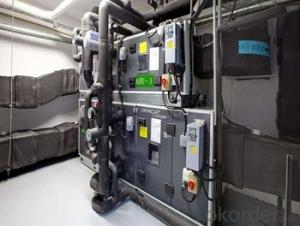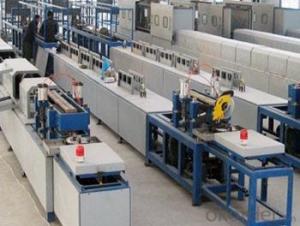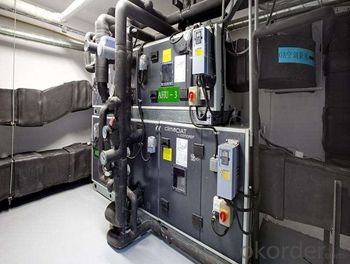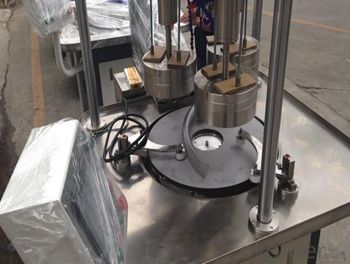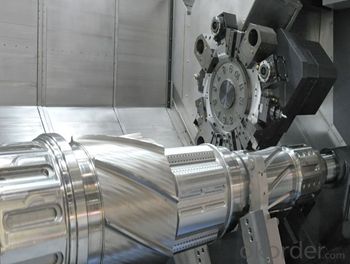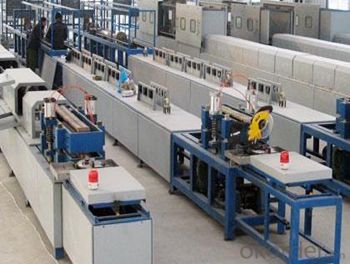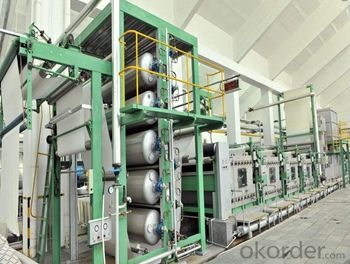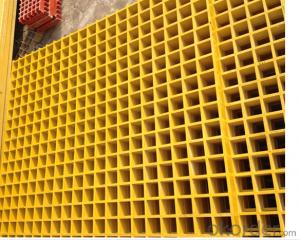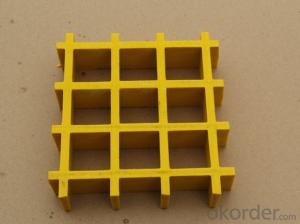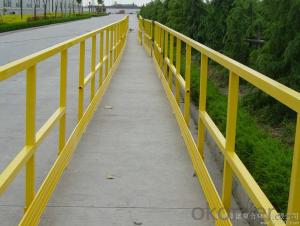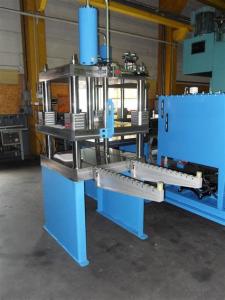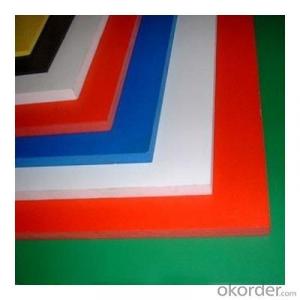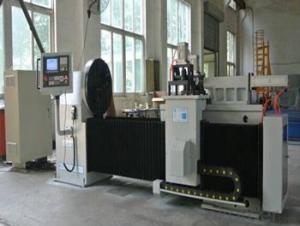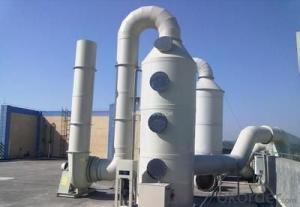FRP Pultrusion Profiles - FRP Pultruded Grating with Anti-Corrosion, Anti-Rust, and Best Quality on Hot Sales
- Loading Port:
- Tianjin
- Payment Terms:
- TT OR LC
- Min Order Qty:
- 4000 m.t.
- Supply Capability:
- 300000 m.t./month
OKorder Service Pledge
OKorder Financial Service
You Might Also Like
PRODUCT DESCRIPTION
Pultruded grating is made by a particular assembly process, which using “I” shape as its main load-bearing and special rod to go through the bearing bar. Pultruded grating include the standard grating and the custom grating, the custom grating can be designed to meet customer’s requirement or special using condition by changing the shape, size and space of the bearing bars, the surface can be covered with lozenge panel, grit panel, or added the anti-slippery sand directly.
FRP pultruded grating has the most characteristics of molded grating, but it has its distinct advantages, it has very high fiberglass content in the loading direction, so it has very high load capability, it has more superiority when used at wide span, so that the basic support will be decreased and the project cost will be reduced accordingly.
SPECIFICATION
Thickness (mm) | Bar width (mm) | Open space (mm) | Open rate (%) | Approx weight (kg/m |
25.4 | 15.2 | 22.8 | 60 | 13.2 |
25.4 | 15.2 | 15.2 | 50 | 15.9 |
25.4 | 15.2 | 10.1 | 40 | 18.5 |
25.4 | 40 | 10.8 | 21 | 14.5 |
38.1 | 15.2 | 22.8 | 60 | 15.8 |
38.1 | 15.2 | 15.2 | 50 | 19.1 |
38.1 | 15.2 | 10.1 | 40 | 22.4 |
50.8 | 25.4 | 25.4 | 50 | 16.6 |
50.8 | 25.4 | 12.7 | 33 | 21.1 |
CHOICE FOR PULTRUDED GRATING
Resin: GP resin, ISO resin, VE resin, Phenol resin
Color choice: Yellow, gray, green, custom color
Surface choice: Groove surface, grit surface, lozenge cover surface
FEATURES
a. Anti-corrosion and anti-rust
b. Light weight and high strength
c. Anti-flammable
d. Anti- fatigue
e. Safe and anti-slippery
f. Anti-ageing
g. Easy of maintenance
h. Excellent electromagnetism property
i. Good economic benefit
FIELDS SERVED
Sewage treatment,
water supply and drainage,
chemical industry,
oil industry,
power engineering,
pulp and paper.
APPLICATION
Operation terrace,
stair walkway,
ground floor,
trench cover,
sidewalk,
foot bridge,
equipment safety fence,
scaffold.
COMPANT DESCRIPTION
CNBM,China National Building Materials Group is a state-owned enterprise in charge of administrative affairs in china building materials industry. Established in 1984, CNBM is a large group corporation of building materials with total assets of 25 billion RMB and a total staff of 30,000.CNBM now owns 200 subordinating firms of solely owned and joint-venture companies.
CNBM International Corporation is one subsidiary of CNBM, we focus on offering good-quality products,professional service and complete solution to our customers. Strong delivery capacity, advanced technology& management, strong financing capability and excellent after-sale service are our advantages in sharing international market.
FAQ
1.Q:Are you factory or trading company ?
A:We are Factory produce FRP machines and FRP products.
2.Q:If can customized by customers requirements?
A:yes,we can produce the machine with customized size.
3.Q:How about the payment?
A:We accept any kind of payment.
4.Q:What is the guarantee?
A:Gurantee is one year.
5.Q:If you can training?
A:yes ,we can training in our factory also can send engineers to your factory training.
PICTURES
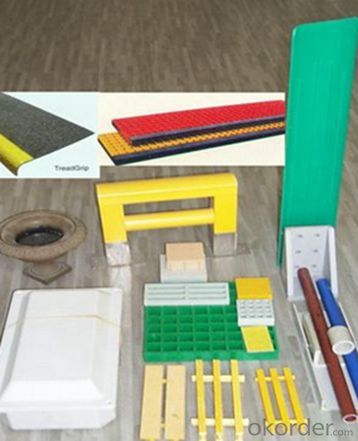
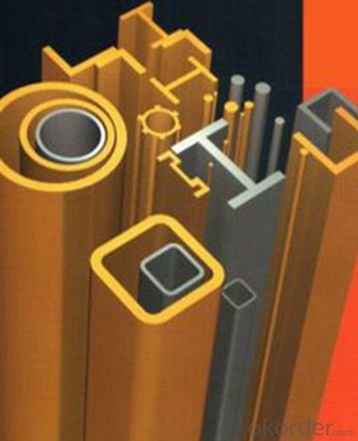
- Q: How do FRP pultrusion profiles handle cyclic loading?
- FRP pultrusion profiles are known for their excellent resistance to cyclic loading. The combination of the fiber reinforcement and the resin matrix in the pultrusion process results in a highly durable and fatigue-resistant material. The inherent strength and stiffness of the fibers help to distribute the applied loads evenly, while the resin matrix absorbs and dissipates the energy from cyclic loading, preventing crack propagation and failure. This makes FRP pultrusion profiles a reliable choice for applications that involve repeated or fluctuating loads.
- Q: What is the flexural strength of FRP pultrusion profiles?
- The flexural strength of FRP pultrusion profiles is not fixed and can fluctuate depending on the particular composite materials utilized and the method of manufacture. These profiles are purposely designed to possess high strength-to-weight ratios and are capable of displaying flexural strengths ranging from approximately 300 MPa (43,500 psi) to over 1,000 MPa (145,000 psi). Several factors have an impact on the flexural strength of FRP pultrusion profiles, including the fibers' type and orientation, the resin matrix, the manufacturing technique, and any additional reinforcement or additives. For instance, carbon fibers generally yield superior flexural strengths when compared to glass fibers due to their inherent stiffness and strength properties. It is important to acknowledge that the flexural strength can differ based on the specific application and design prerequisites. Engineers and manufacturers typically undertake testing and analysis to ascertain the flexural strength characteristics of FRP pultrusion profiles tailored for their intended usage. This ensures compliance with safety standards while considering factors such as load demands, environmental conditions, and anticipated service life.
- Q: What is the maximum length of FRP pultrusion profiles that can be manufactured?
- The maximum length of FRP (Fiber Reinforced Polymer) pultrusion profiles that can be manufactured depends on various factors such as the specific manufacturing process, equipment capacity, and transportation limitations. In general, FRP pultrusion profiles can be manufactured in lengths ranging from a few feet to several hundred feet. However, there are certain practical limitations that need to be considered. Firstly, the length of the pultrusion profiles is often limited by the size and capacity of the pultrusion equipment used in the manufacturing process. Different pultrusion machines have varying capabilities, and their length capacities can range from a few feet to over 100 feet. Manufacturers must consider the available equipment and its limitations when determining the maximum length of the profiles they can produce. Additionally, transportation and logistical constraints may also impact the maximum length of FRP pultrusion profiles. Longer profiles can be more challenging to transport due to restrictions on road transport, shipping containers, or handling capabilities. These limitations may vary depending on the region, infrastructure, and transportation methods available. It is important to note that longer profiles may also face challenges in terms of quality control and dimensional stability during manufacturing. As the length increases, it becomes more difficult to maintain consistent mechanical properties and control the curing process effectively. Therefore, while there is no fixed maximum length for FRP pultrusion profiles, it is crucial for manufacturers to consider the technical capabilities of their equipment, transportation logistics, and quality control factors when determining the practical limit for the length of their products.
- Q: Can FRP pultrusion profiles be used in wastewater treatment facilities?
- Yes, FRP pultrusion profiles can be used in wastewater treatment facilities. FRP (Fiber Reinforced Plastic) pultrusion profiles are known for their high strength, corrosion resistance, and durability, making them suitable for various applications, including in harsh environments like wastewater treatment facilities. These profiles can be used for constructing structures, such as walkways, handrails, grating, and tanks, as well as for reinforcing or replacing traditional materials, such as steel or concrete, in different components of the facility. The corrosion resistance of FRP pultrusion profiles ensures their longevity and reduces maintenance costs, making them a viable option for wastewater treatment facilities.
- Q: Can FRP pultrusion profiles be used in electrical or telecommunications applications?
- FRP pultrusion profiles have a wide range of applications in the electrical and telecommunications industries. These profiles are highly regarded for their exceptional electrical insulating properties, impressive strength-to-weight ratio, and resistance to corrosion. As a result, they are well-suited for various electrical and telecommunications purposes. When it comes to electrical applications, FRP pultrusion profiles can function as electrical insulators, cable trays, busbar supports, and electrical enclosures. They serve to insulate and safeguard against electrical shocks, making them a popular choice for replacing traditional materials like metal or wood. Moreover, their non-conductive properties, along with their lightweight and easy installation, make them highly suitable for electrical applications. In the realm of telecommunications, FRP pultrusion profiles are utilized for cable management systems, antenna supports, and equipment enclosures. Similar to their electrical applications, the non-conductive nature of these profiles ensures the safety and reliability of the telecommunications infrastructure. Additionally, these profiles can be tailored to meet specific design requirements, such as incorporating cable routing channels or equipment mounting brackets. Furthermore, FRP pultrusion profiles exhibit exceptional resistance to harsh environmental conditions, such as moisture, UV radiation, and chemicals. This makes them an excellent choice for outdoor electrical or telecommunications installations, where exposure to these elements is commonplace. All in all, FRP pultrusion profiles have proven themselves to be a dependable and cost-effective option for electrical and telecommunications applications. They provide insulation, strength, durability, and resistance to environmental factors, making them highly sought-after in these industries.
- Q: Can FRP pultrusion profiles be used in pedestrian bridges?
- Yes, FRP pultrusion profiles can be used in pedestrian bridges. FRP (Fiber Reinforced Polymer) pultrusion profiles offer several advantages such as high strength-to-weight ratio, corrosion resistance, and durability, making them suitable for pedestrian bridge applications. These profiles can be customized to meet specific design requirements, ensuring the safe and efficient construction of pedestrian bridges.
- Q: How do FRP pultrusion profiles handle torsion loads?
- FRP pultrusion profiles are designed to handle torsion loads effectively due to their inherent properties. The continuous fibers in the profile provide excellent resistance to torsional forces, ensuring high strength and stability. The pultrusion manufacturing process also allows for precise control over the fiber orientation, resulting in profiles that can efficiently handle torsion loads without compromising their structural integrity.
- Q: What is the cost of FRP pultrusion profiles compared to other materials?
- The cost of FRP pultrusion profiles is generally lower compared to other materials such as steel or aluminum. This is due to the relatively low cost of raw materials used in the manufacturing process, as well as the efficiency and speed of the pultrusion production method. Additionally, the long lifespan and low maintenance requirements of FRP pultrusion profiles make them a cost-effective choice in the long run.
- Q: Are FRP pultrusion profiles resistant to humidity or moisture?
- Yes, FRP pultrusion profiles are highly resistant to humidity or moisture due to their non-porous nature and the use of corrosion-resistant materials.
- Q: Do FRP pultrusion profiles have any limitations or drawbacks?
- Yes, FRP pultrusion profiles do have certain limitations and drawbacks. One limitation is that FRP pultrusion profiles have lower stiffness compared to traditional materials like steel or aluminum. This means that they may not be suitable for applications that require high structural rigidity or heavy loads. Another limitation is that FRP pultrusion profiles are prone to creep, which is the gradual deformation of the material under a constant load over time. This can negatively affect the long-term performance and durability of the profiles, especially in applications where they are subjected to sustained stress. Additionally, FRP pultrusion profiles are generally more expensive to produce compared to traditional materials. The manufacturing process involves pultruding continuous fibers through a resin matrix, which requires specialized equipment and expertise. This can result in higher production costs, making FRP pultrusion profiles less cost-effective for certain applications. Furthermore, FRP pultrusion profiles are generally not suitable for high-temperature applications. The resin matrix used in their production can degrade or soften at elevated temperatures, limiting their use in environments where thermal resistance is critical. Lastly, FRP pultrusion profiles may have limited design flexibility compared to other materials. The pultrusion process typically produces profiles with constant cross-sections and limited geometric complexity. This can restrict their use in applications that require intricate shapes or customized designs. Despite these limitations and drawbacks, FRP pultrusion profiles offer several advantages such as high strength-to-weight ratio, corrosion resistance, and electrical insulation properties. It is important to carefully consider the specific requirements of the application before opting for FRP pultrusion profiles.
Send your message to us
FRP Pultrusion Profiles - FRP Pultruded Grating with Anti-Corrosion, Anti-Rust, and Best Quality on Hot Sales
- Loading Port:
- Tianjin
- Payment Terms:
- TT OR LC
- Min Order Qty:
- 4000 m.t.
- Supply Capability:
- 300000 m.t./month
OKorder Service Pledge
OKorder Financial Service
Similar products
Hot products
Hot Searches
Related keywords
